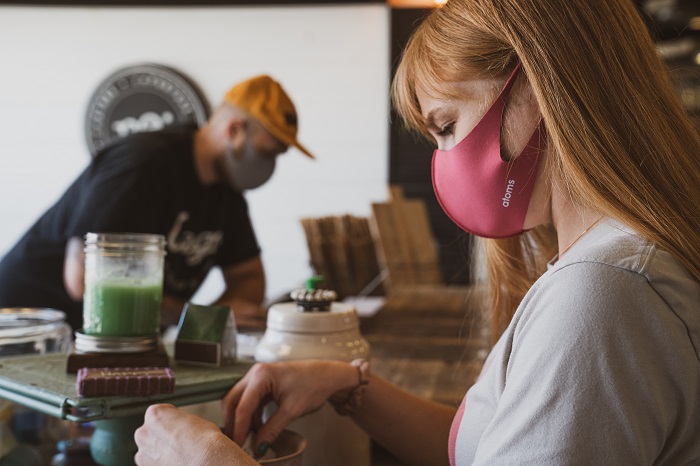Overview:
Per the latest COVID-19 health order of the LA County Department of Public Health dated January 10, 2022 (the “Health Order”), there are new COVID-related rules that employers and employees must follow. The Health Order is effective within all cities and unincorporated areas within the County of Los Angeles, except for the cities of Long Beach and Pasadena (which must follow their own respective City Health Officer orders and guidance). The Health Order became effective on January 11, 2022 and continues until further notice. One key requirement of the Health Order is that employers must provide medical-grade masks to all of their employees working indoors. Other requirements include isolation and quarantine measures for employees who become infected with COVID-19 or are exposed to an infected person. The latest order from the California Department of Public Health (January 5, 2022) also requires the use of face coverings by all employees working indoors. Employers must also comply with the comprehensive Cal/OSHA Emergency Temporary Standards (“ETS”). The ETS were updated in December 2021 to include information about employees returning to work after “close contact” with an infected person, and the latest revisions became effective on January 14, 2022. Finally, testing for COVID-19 in the workplace and taking appropriate remedial actions remain important, as well as posting signage at entranceways reminding visitors to wear a mask.
Providing Masks:
The Health Order requires indoor masking by all persons, regardless of vaccination status, in an effort to slow the spread of COVID-19 in Los Angeles County. Starting on January 17, 2022, employers must provide their employees (who work indoors and in close contact with other workers or the public) with a well-fitting medical grade mask, surgical mask, or higher-level respirator (such as an N95 filtering facepiece respirator or KN95) at all times while indoors at the workplace. Employers are required to ensure their employees are actually wearing such face coverings during working hours while they are indoors at the workplace, absent any applicable exemptions such as a medical condition or critical safety considerations. If any employee is found to be not wearing their mask while at work, they should be promptly reminded of the requirement to do so. Where multiple occasions of non-compliance are observed, the employee should be “written-up” and informed that they are in violation of the County’s Health Order, as well as the requirements set forth by the California Department of Public Health.
Isolation and Quarantine Requirements:
The Health Order includes isolation and quarantine requirements for employees who become infected with COVID-19 or are exposed to an infected person. These requirements are broken down into the following three primary categories: (i) isolation requirements for infected employees (regardless of vaccination status, previous infection, or lack of symptoms), (ii) quarantine requirements for employees who have been exposed to an infected person (applicable to employees who are not up to date with their COVID-19 vaccinations, including boosters), and (iii) quarantine exemptions for employees who have been exposed to an infected person (applicable to employees who are up to date with their COVID-19 vaccinations, including boosters, or who have recovered from lab-confirmed COVID-19 within the prior 90 days). Each of these three categories is further described below.
Category 1: Isolation Requirements. Every employee who becomes infected must isolate, regardless of vaccination status, previous infection, or lack of symptoms. Such employees must be excluded from the workplace and they are required to self-isolate in accordance with the County’s isolation instructions.
Isolation for 5 Days. Such isolation can end (and the employee may return to the workplace) after the fifth day of isolation if all of the following criteria are met: (i) a COVID-19 test (taken on day 5 or later) is negative (note: the test must be a viral test such as an antigen or NAAT/PCR test, and testing must be provided by the employer free of charge and during work hours), (ii) no fever is present for at least 24 hours without the use of fever-reducing medicine, and (iii) other COVID-19 symptoms are improving.
Isolation for 10 Days. Where no test is taken, or where such test is positive, the isolation period can end (and the employee may return to the workplace) after the tenth day of isolation if all of the following criteria are met: (i) no fever is present for at least 24 hours without the use of fever-reducing medicine, and (ii) other COVID-19 symptoms are not present or are improving.
All employees subject to this self-isolation category must wear a well-fitting medical grade mask around others for a total of 10 days after their initial positive test, especially in indoor settings. Note that for symptomatic employees, day 0 is the first day of symptoms and day 1 is the first full day after symptoms developed. And for employees without symptoms, day 0 is the day the first positive test was collected and day 1 is the first full day after the positive test was collected.
Category 2: Quarantine Requirements. These requirements apply to employees who are not up to date with their COVID-19 vaccinations, including boosters, and who have been exposed to an infected person (i.e., the employee is considered a “close contact” of an infected person). An employee is considered a “close contact” if they were exposed to someone who tested positive for COVID-19 and, while such infected third party was infectious, the employee (i) was within 6 feet of the third party for a total of 15 minutes or more over a 24-hour period, and/or (ii) had unprotected contact with body fluids and/or secretions from the third party (e.g., the employee was coughed or sneezed on, shared a drinking cup or eating utensils, kissed with the third party, or provided care to them without wearing the appropriate personal protective equipment).
Except where permitted by the employer under certain circumstances (as described below), such employees must be excluded from the workplace for 5 days after they were in “close contact” with an infected person, and they must quarantine and follow the rules for close contacts required by the County’s quarantine instructions. After day 5, the employee should get tested. If the test is positive, they must self-isolate in accordance with the County’s isolation instructions. If the test is negative, the quarantine period can end and the employee may return to the workplace after day 5 only if symptoms are not present and a viral test collected on day 5 or later is negative.
If an employee is unable to, or chooses not to, test and does not have symptoms, then the quarantine period can end and the employee may return to the workplace after day 10. If, however, symptoms develop, then the employee must stay home and be excluded from work pending the results of a test. If they test positive, they must follow the County’s isolation requirements.
All employees falling under this category must wear a well-fitting medical grade mask around others for at least 10 days after their last exposure to COVID-19, especially in indoor settings.
Exception to Full Quarantine Requirement (at Employer’s Discretion): Employees who are vaccinated and booster-eligible (but have not yet received their booster dose), who also do not have symptoms may be allowed by their employer to go to work if all of the following occur: (i) the employee gets tested 3-5 days after their last exposure to the infected person they came into close contact with, and the result is negative, (ii) the employee wears a well-fitting medical-grade mask (ideally an N95/K95) around others indoors and outdoors for a total of 10 days and does not eat or drink around others, (iii) the employee continues to have no symptoms, and (iv) the employee quarantines at home when they are not at the workplace.
Category 3: Quarantine Exemptions. This applies to any employee who has been exposed to an infected person, but where such employee is either up to date with their COVID-19 vaccinations (including boosters) or fully recovered from lab-confirmed COVID-19 within the prior 90 days. The employee must also have no COVID-19 symptoms to fall under this category. Such employees do not need to quarantine and may continue to work, provided that (i) on or after the fifth day after exposure, the employee gets tested and the result is negative (if the test is positive, they must self-isolate in accordance with the County’s isolation instructions), or (ii) if the employee is unable to, or chooses not to, test and does not have symptoms, then they must wear a well-fitting medical grade mask and maintain 6 feet of distance from others in the workplace for 14 days. If, however, symptoms develop, then the employee must stay home and be excluded from work pending the results of a test. If they test positive, they must follow the County’s isolation requirements.
All employees falling under this category must wear a well-fitting medical grade mask around others for at least 10 days after their last exposure to COVID-19, especially in indoor settings.
For all of the categories listed above, and in establishments or settings with active outbreaks, the above-described quarantine and isolation periods may be extended by County Public Health outbreak investigators in an effort to help lower the risk of ongoing transmissions at the impacted location.
Additional information on isolation and quarantine requirements can also be found in the ETS, which employers must be familiar with and adhere to.
Testing for COVID-19:
Under current law, employers must inform their employees on how the employees can obtain COVID-19 testing. Employees that are workplace “close contacts” must have testing made available to them at no cost during paid working hours, with the employer footing the bill (with exclusions for asymptomatic close contacts who are fully vaccinated or who were a COVID-19 positive case within the past 90 days). Employees with insurance can contact their doctor to get tested at no cost to the employee. Employees with no insurance, or whose doctors cannot provide testing, can call 2-1-1 for help finding a free testing site. Note that the ETS states that employers must offer testing (at no cost to employees) during paid working time to the following employees: (i) symptomatic unvaccinated employees, regardless of whether there is a known exposure, (ii) unvaccinated employees after an exposure, (iii) vaccinated employees after an exposure if they develop symptoms, (iv) unvaccinated employees in an outbreak, and (v) all employees in a major outbreak.
Responding to COVID-19 in the Workplace:
Employers should have procedures in place for seeking information from employees related to COVID-19 cases and close contacts in the workplace. This includes collecting and keeping records of all COVID-19 cases, including their date of symptom onset, COVID-19 testing dates and results, last date present at the workplace, and their workplace close contacts (for contact tracing and notification purposes). Once a positive COVID-19 case is identified at the workplace, the employer must (i) tell the employee to follow the County’s isolation instructions and not return to work until their isolation is completed, (ii) determine who may have been a close contact at the workplace, including assessing the infected employee’s activities and workplace locations while they were contagious, (iii) inform all close contacts in the workplace via written notice of their exposure within 1 business day and provide instructions as to how to proceed, (iv) consult the “Best Practices in the Workplace to Prevent the Spread of COVID-19” and take the appropriate actions to reduce future workplace exposures to COVID-19, and (v) report a potential outbreak to the County’s Department of Public Health if three or more cases of COVID-19 are known or reported among employees within a 14-day period.
Signage at Business Entrance:
Every business establishment in Los Angeles must post signage informing its customers and others entering the premises that masks are required. Examples of such signage can be found here and here.
Conclusion:
The Health Order and Cal/OSHA’s ETS require employers to take numerous actions to protect their workers (and patrons) from hazards related to COVID-19. The requirements are robust and employers must have a comprehensive and compliant COVID-19 prevention plan in place, along with the policies, procedures, and infrastructure to ensure compliance with such plan. We highly recommend that employers routinely check the websites linked in this article as well as other applicable government websites describing the then-current rules, regulations, and guidelines. Maintaining full compliance in this is ever-changing environment is a moving target, and savvy employers should consult with experienced legal counsel to determine which rules apply to them and how best to comply.








